Politics and government of the Dutch Republic

The Dutch Republic was a confederation of seven provinces, which had their own governments and were very independent, and a number of so-called Generality Lands. These latter were governed directly by the States-General (Staten-Generaal in Dutch), the federal government. The States-General were seated in The Hague and consisted of representatives of each of the seven provinces.
Summary
When several provinces and cities in rebellion against Philip II of Spain (Brabant, Guelders and Zutphen, Flanders, Holland, Zeeland, Friesland, Mechelen, Utrecht, Groningen, Overijssel and Drenthe) declared themselves independent in 1581 with the Act of Abjuration, they initially aspired to appoint another prince as head of state. The sovereignty of the provinces was first offered to Francis, Duke of Anjou, but his 1583 coup d'état was foiled and he was ousted. After the assassination of rebel leader William the Silent, it was offered in turn to and declined by Henry III of France and Elizabeth I of England. Elizabeth did make the provinces an English protectorate and sent over the Robert Dudley, Earl of Leicester as governor-general (Treaty of Nonsuch, 1585). For many reasons, it was not a success, and Leicester left in 1588. This left the provinces in rebellion without a head.
The provinces of the republic were, in official feudal order: the duchy of Guelders (Gelre in Dutch), the counties of Holland and Zeeland, the former bishopric of Utrecht, the lordship of Overijssel, and the free (i.e. never feudalised) provinces of Friesland and Groningen. In fact there was an eighth province, the lordship of Drenthe, but this area was so poor it was exempt from paying confederal taxes and, as a corollary, was denied representation in the States-General.
After the Peace of Westphalia, several border territories were assigned to the United Provinces. They were federally governed Generality Lands (Generaliteitslanden). They were Staats-Brabant (present North Brabant), Staats-Vlaanderen (present Zeeuws-Vlaanderen), Staats-Overmaas (around Maastricht) and Staats-Opper-Gelre (around Venlo, after 1715).
One should also not suppose the republican form of government was democratic, in the modern sense that every citizen had a vote. In the 16th, 17th and 18th centuries, the regenten (the Dutch plural for regent) were the rulers of the Dutch Republic, the leaders of the Dutch cities or the heads of organisations (e.g. "regent of an orphanage"). Since the late Middle Ages Dutch cities had been run by the richer merchant families. Though not formally a hereditary "class", they were de facto "patricians", comparable in some sense to that ancient Roman class. At first the lower-class citizens in the guilds and schutterijen could unite to form a certain counterbalance to the regenten, but in the course of the 16th, 17th and 18th century the administration of the cities and towns became oligarchical in character, and it became harder and harder to enter their caste. From the latter part of the 17th century the regent families were able to reserve government offices to themselves via quasi-formal contractual arrangements. Most offices were filled by co-option for life. Thus the regent class tended to perpetuate itself into a closed class. However, in practice they had to take into account the opinions of the man on the street, otherwise they ran the risk of being dislodged by political upheavals, like the Orangist revolutions of 1672 and 1747 and the Patriot revolt of 1785.[1] [2]
National government
The States-General (in Dutch "Staten-Generaal") or the Generality ("Generaliteiten") for short was a descendant of the medieval Burgundian and Habsburg States-Generals. In medieval times and under the Habsburgs, they met infrequently to discuss matters of common interest and to vote taxes for the benefit of the Dukes of Burgundy and their Habsburg heirs.[3] After the abjuration of the king in 1581 and the separation of the northern Netherlands from the Spanish dominions, the States-General replaced the king as the supreme authority and as the central government of the northern Netherlands, which then became known as the United Provinces. As alluded to above, this was an ad hoc arrangement since no prince would anger Spain by accepting sovereignty over the provinces. As the years went by, and the confidence of the governing regents and Princes of Orange grew, the desire to be ruled by a foreign prince diminished.[4]
.svg.png) |
.svg.png) |
|---|---|
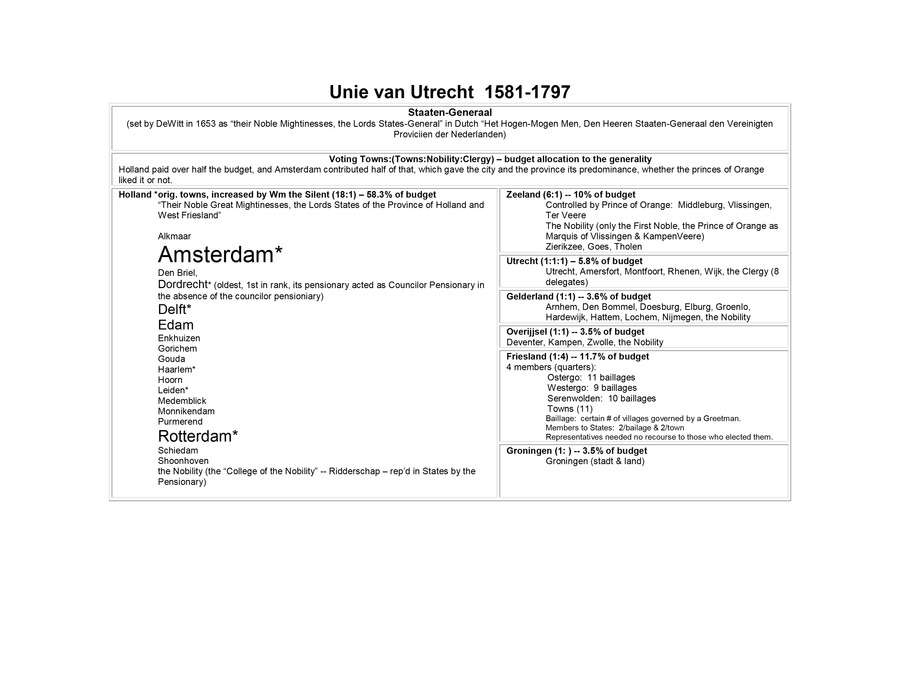
The style of address to the States-General was codified by Johan de Witt in 1653 as "their Noble Mightinesses, the Lords States-General" or, in Dutch, "Den Heeren Hoog-Mogenden, Den Heeren Staten-Generaal der Verenigde Provinciën der Nederlanden").[5]
Each province was allowed one vote in the States-General, and the Republic continued this practice. Each province could send as many representatives as they chose. However, the size of the meeting room limited the size of the delegations. The representatives were appointed for a term by the provincial estates and were not directly elected. Neither were they usually empowered to vote on their own decision. Referrals back to the provincial estates for a decision on how to vote were frequent. The system only worked when a talented Councilor Pensionary or Stadholder (Prince of Orange) was able to arrange a consensus ahead of time. Meetings were held around a large conference table in the Binnenhof (the former palace of the counts of Holland), in the Hague, which was a central location and allowed easy travel back and forth to the other provinces. Of course, the States of Holland met in the same palace, so communication with them was easy, which also increased their influence. Each province served as presiding officer of the States-General in turn. Given this weak executive structure, and the necessity to refer business for detailed review, the proceedings were often dominated by the Councillor Pensionary of Holland as the representative of the largest province, as well as the most well informed and prepared official. Representatives of Holland as well as other provinces would often defer to his expertise.[5]
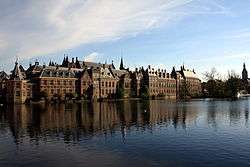
The States-General conducted foreign relations, declared war and peace, administered the army and navy, and levied tariffs. In short, it did all those things that concerned the outward and common concerns of the Republic. But no more. It had negligible power internally, which was jealously guarded by the provincial States.
One of the most important tasks of the States-General was the appointment of the commander of the Republic's armies, the Captain General of the Union. The appointment was for life. William the Silent acted as chief commander of the army as the most eminent personage and the leader of the rebellion, but this was never formalized. His son, Maurice was appointed Captain-General as a counterpose to Leicester. The Dutch were fortunate in this in that Maurice turned out to be a military genius and the foremost commander of his age. After that, it was a matter of course for the incumbent Prince of Orange to be appointed Captain General. The ability of the Princes to deliver victory and protect the Republic from its enemies lead to much of their political power. The failure of the latter Princes (William IV of Orange and William V of Orange) to live up to this heritage consequently led to a large diminution of their power internally.
Once the budget for the year was set (as might be expected a subject of much negotiation), the percentage to be paid into the treasury of the Generality was set by tradition. As the largest, most populous, and richest province, Holland paid 58.3% of the required budget. The ability to provide this proportion of the Generality's funds is what gave the States of Holland (and as will be seen below the city of Amsterdam and its ruling burghers) their preponderance in the government. Zealand contributed 10% to the budget, Friesland 11.7%, Utrecht 5.8%, Gelderland 3.6%, Overijjsel 3.5%, and Groningen 3.5%. The poorer and more landward provinces were accessed less. The treasury of the Generality was administered by an official appointed by the States-General, the Treasurer-General. He chaired the Treasury Chamber of the Generality ("Rekenkamer") and kept its books. There was also a Receiver-General, who collected the taxes as well as the contributions of the member Provinces. One of the key problems in this is that the Receiver-General had no authority to enforce payment into the treasury, and some of the poorer provinces were frequently in arrears.[5]
Twenty per cent of the new Republic's territory, known as the Generality Lands (see above), was not assigned to any provincial council and had been conquered since 1581 from the Spanish. It was under the direct rule of the Generality, and not allowed to send representatives to the States-General. As such, these territories had no vote in the States-General.
The Council of States ("Raad van State") of the Generality functioned as the executive committee of the Union, and carried out its executive functions. It was descended from the Councils of States formed by the Burgundian Dukes and the Habsburgs. This incarnation was formed when Leicester became governor-general. After he left, it was made subordinate to the States-General, and functioned as a subcommittee of it. It formulated the budget, organized and financed the army and navy (although naval policy was set by the Council of the Admiralty, as below), and levied taxes throughout the Union. It consisted of 12 members, appointed by the provinces, for 2, 3, or 4 years as the individual provinces chose. Its members also tended to be the province's representatives to the States-General, as the Council was a subordinate to it. The councilors, in break with general practice, voted individually, not by province. Each councilor presided in turn. It members fixed by tradition to:
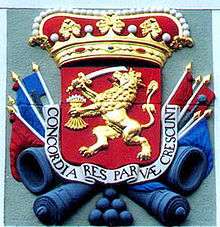
- The Prince of Orange as Captain-General of the Union's Army and Admiral-General of the Navy.
- Holland - 3 councilors, one of which was the Councillor Pensionary of Holland.
- Zeeland - 2 councilors
- Utrecht - 2 councilors
- Friesland - 1 councilor
- Overijssel - 1 councilor
- Groningen - 1 councilor[5]
The administration of the navy of the Union (see also Naval history of the Netherlands) and supervision of all its naval affairs was centered in another committee of the States-General, the Council of the Admiralty. It was responsible for setting naval policy and budget. Members were appointed by the states general and consisted of:
- The Prince of Orange as Admiral-General of the Union (again, a lifetime employment).
- The Lieutenant Admiral-General of the Union - this was second only to the Admiral-General, and was the effective operational commander of the Navy He was most important when there was no Admiral-General/Prince of Orange appointed. Michael de Ruyter served as Lt. Admiral in his time.
- The Councillor-Pensionary of Holland, whose influence here was greater than in the army, and paramount when there was no Prince of Orange. Johan de Witt effectively commanded the navy through this position.
- others as appointed
For day-to-day administration of the navy, there were originally three different subordinate Admiralties: Rotterdam/the Maas/Southern Quarter of Holland, Amsterdam/Northern Quarter (1587), and the Zeeland (based in Middleburg). To this was added the Norder Kwartier (separated from Amsterdam, and alternatively based in Hoorn and Enkhuizen). In 1597 the States of Friesland established the Friesland (based in Harlingen). On 14 June 1597 the States-General of the Netherlands, approved a proposal in which the foundation of a Generaliteitscollege was decided upon; this replaced an earlier navy board, the Collegie Superintendent, of which Maurice of Nassau, Prince of Orange (Admiral-General since 1588) had been the head, but which had been dissolved in 1593 as a result of disputes between the provinces. The Generaliteitscollege was to be a loose cooperation between five autonomous Admiralties to be represented in it. Each admiralty also had its own hierarchy. However, most ships and money came from Amsterdam, and after that Rotterdam and Zeeland. The situation tended to lead to divided command in battle and duplication of efforts, which could only be resolved by a strong Prince of Orange or Councilor Pensionary.[1]

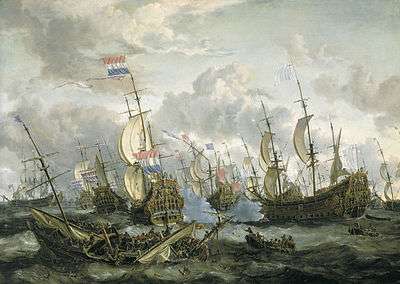
One common confusion is that the office of the stadholder was a national one. It was not. The stadholder had been appointed by the sovereign (the Dukes of Burgundy or the Habsburgs) in each province as his representative. In the absence of the sovereign, the provincial estates appointed their stadholder. The term of office was for life. While it was held by the incumbent Prince of Orange, it was not made hereditary until the time of William IV. However, the Prince of Orange was not just another appointed servant of each of the provincial States, as the Councillor Pensionary was, nor not just another noble among equals in the Netherlands. First, he was the traditional leader of the nation in war and in rebellion against Spain as the direct descendant of William the Silent, the father of the fatherland. He was uniquely able to transcend the local issues of the cities, towns and provinces. He was also a sovereign ruler in his own right (see Prince of Orange article). This gave him a great deal of prestige, even in a republic. He was the center of a real court like the Stuarts and Bourbons, French speaking, and extravagant to a scale. It was natural for foreign ambassadors and dignitaries to present themselves to him and consult with him as well as to the States General to which they were officially credited. The marriage policy of the princes, allying themselves twice with the Royal Stuarts, also gave them acceptance into the royal caste of rulers. The leaders in the individual provinces as well as the States-General looked to him for leadership and guidance. A strong Prince of Orange (those of the 17th century) could make the institutions of the Republic work efficiently. A weak Prince of Orange (those of the 18th century) would contribute greatly to the weakness of the government and the Republic.[1]
The Dutch East India Company and the Dutch West India Company, as quasi governmental organizations, were also under its general supervision along with the provincial and city boards of governors of the corporations. Staten Island in New York City (originally New Amsterdam) and Staten Island, Argentina (Discovered by Dutchman Jacob le Maire), are among places named after the Staten-Generaal.
Government of Holland
The province of Holland was governed from the earliest times by the Provincial States. This was an assembly of all the commons and nobles (though not clerics as in other countries) to the sovereign, the count of Holland. They also met in the Hague at the Binnenhof. The fact that their center of political power was also the de facto political center of the Republic gave them an advantage of the other provinces in addition to the 58.3% of the country's budget they paid. In 1653 de Witt formalized their title as "their Noble Great Mightinesses, the Lords States of the Province of Holland and West Friesland". The fact that it was more laudatory than the States-General above showed where the real power lay.[5]
.jpg)
The States of Holland met 4 times per year. Each city and town represented in the States had one vote, along with the College of the Nobility of Holland (Ridderschap in Dutch), which also had one vote. Each town could send as many representatives as it deemed necessary. The number of towns with voting privileges was originally 6: Dordrecht was the first in rank. Its pensionary acted as Councilor Pensionary if necessary. The others were Delft, Rotterdam, Amsterdam, Haarlem and Leiden. The number of voting towns was increased by William the Silent to 18 to respond to the growing population. Those were: Alkmaar, Den Briel, Edam, Enkhuizen, Gorichem, Gouda, Hoorn, Medemblick, Monnikendam, Purmerend, Schiedam, and Schoonhoven. These were not changed until the end of the Republic.[1]
The same method was used to raise revenue as was used in the States-General. Each city was charged its portion. Amsterdam paid almost 50% of the revenues/budget of Holland. Given Holland's contribution to the Generality's budget (above), Amsterdam paid approximately 25% of the entire national budget alone. This is part of what gave that city its preponderance in national and provincial affairs.[5]
The Nobility was not very numerous in Holland, Holland was not very heavily feudalized. However, they still had a certain amount of prestige in an aristocratic age. They also had many prerequisites by tradition, such as the right to be appointed to certain lucrative posts and sinecures. Their hall (in Dutch the Ridderzaal) was at the center of the Binnenhof. The Nobility usually had 8 or 9 of their number as representatives to the States. The office of Chief Noble of Holland an especially lucrative sinecure, although appointment was by the States. Some of its holders were Louis of Nassau, Lord of De Lek and Beverweerd and Joan Wolfert van Brederode They chaired the meetings of the States, as represented by their Pensionary, who was also counselor (retained legal advisor) to the States as a whole, hence the name Councilor Pensionary or in Dutch raadpensionaris. This gave the Councilor Pensionary some of his power as he chaired the meetings of the States and spoke first as the representative of the Nobility, as well as last in summing up the debates. He was also the only representative with a fixed term (3 years, extended to 5 years by the time of De Witt), an office, and the staff to prepare and study issues.
The main executive functions of Holland were carried out by the Gecommitteerde Raden, usually translated as Delegated Councilors. They formed a permanent committee of the States, with delegates from:
- The Nobility - 1 delegate, represented by the Councilor Pensionary
- Amsterdam - 1 delegate
- Dordrecht - 1 delegate
- Rotterdam - 1 delegate
- Haarlem - 1 delegate
- Leiden - 1 delegate
- Delft - 1 delegate
- Gouda - 1 delegate
- 1 delegate from 3 of the smaller towns (i.e. the ones not mentioned above), each of the 3 choosing him by turns.
The Councilor Pensionary exercised much of influence here as he was again, the only representative with a fixed term, an office, and the staff to prepare and study issues, and then to carry them out.[5]
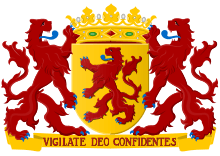
The States of Holland usually sent the following delegates to States General:[5]
- 1 noble – perpetual
- 2 out of the 8 chief/original towns
- 1 out of the towns of North Holland
- 2 from the provincial commissioned councilors
- the Councilor Pensionary of Holland
From his accretion of influence that went along with the committees, meetings of the States and States-General that he attended, and his staff that allowed him to study and carry out decisions, the Councilor Pensionary became by default the main executive official of the States of Holland and the States General. The Councilor Pensionary was appointed for a fixed 5-year term, paid a salary, given a budget and a staff. This allowed him to study, propose, and carry out decisions of the States. He was not the leader (i.e. proto-prime-minister), but as the pensionary of the Nobility and the counselor of the States, a powerful Councilor Pensionary such as De Witt could shape the agenda, its outcome, and use his influence to persuade the other members of the States (who were part-time delegates) to vote for a particular policy, and then carry it out. The same carried through to the States-General, especially as he tended to the face of the most powerful province, Holland. As he was tasked with carrying out decisions, it was natural for other bodies, both domestic and foreign (i.e. ambassadors) to meet with him and deal with him to get the States and States-General to act on an issue.[6]
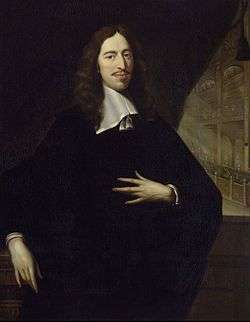
Most of the other provinces (except Friesland, whose government was actually very different[2]) had their own pensionary. However, none of them had the ability to build up the power and influence of the Holland's given Holland's influence in the Generality.
The office of Councilor Pensionary was a continuation of the office of Land's Advocate of Holland (landsadvocaat). That office did much the same functions as the Councilor Pensionary did, chairing meetings of the States of Holland, acting in committee for them, preparing business and agendas, acting a speaker for the nobility, and acting as their legal counselor and head of bureaucracy. The office started in the early 14th century and ended in 1619, when the title was renamed into Councilor Pensionary in response to the crisis of that year between the States of Holland, as represented by Johan van Oldenbarnevelt and the stadholder, Prince Maurice, which the States lost.[7]
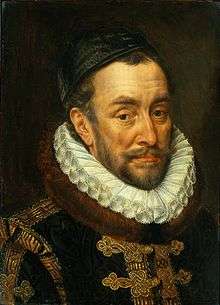
The office of Stadholder (stadhouder in Dutch), was a continuation of the Burgundian institution. Stadtholders in the Middle Ages were appointed by feudal lords to represent them in their absence. Each of the provinces of the Burgundian Netherlands had their own Stadholder, although a Stadholder might exercise authority over more than one province (e.g. William the Silent was Stadholder of Holland, Zealand and Utrect). A stadtholder was thus more powerful than a mere governor, who had only limited authority. In the fifteenth century the Dukes of Burgundy acquired most of the Low Countries, and these Burgundian Netherlands were in turn mostly governed by their own stadtholder. In the sixteenth century, the Habsburg Holy Roman Emperor Charles V, also King of Spain, who had inherited the Burgundian Netherlands, continued this tradition as he had much wider interests in Spain, Germany and Italy. Stadtholders continued to be appointed to represent King Philip II, his son and successor in Spain and the Low Countries. Due to the centralist and absolutist policies of Philip, the actual power of the stadtholders strongly diminished. This was one of the causes of the Dutch Revolt.[3]
When, in 1581, during the Dutch Revolt, most of the Dutch provinces declared their independence with the Act of Abjuration, the representative function of the stadtholder became obsolete in the rebellious northern Netherlands – the feudal Lord himself having been abolished – but the office nevertheless continued in these provinces who now united themselves into the Republic of the Seven United Netherlands. The United Provinces were struggling to adapt existing feudal concepts and institutions to the new situation and tended to be conservative in this matter, as they had after all rebelled against the king to defend their ancient rights. The fact that the stadholder was William the Silent, the effective leader of the revolt, made the States determined to retain him and normalize his position. The stadtholder no longer represented the lord, the States retaining the sovereignty for themselves. He was appointed by the States of each province for that province. It was a provincial office. However, although each province could assign its own stadtholder, in practice the Prince of Orange, the direct descendant of William the Silent, was always appointed to be Stadholder of Holland, Zealand, Utrect, and Gelderland, and the Count/later Prince of Nassau-Dietz, a cadet branch, was appointed Stadholder of Friesland. Groningen and Overijssel appointed one or the other prince as their stadholder (see List of stadtholders for the Low Countries provinces).
The highest executive power was exerted by the sovereign States of each province, but the stadtholder had some prerogatives, like appointing lower officials and sometimes having the ancient right to affirm the appointment (by co-option) of the members of regent councils or choose burgomasters from a shortlist of candidates. As these councils themselves appointed most members of the States, the stadtholder could very indirectly influence the general policy over the course of time. In Zeeland the Princes of Orange, who after the Dutch Revolt most often held the office of stadtholder there, held the dignity of First Noble, and were as such a member of the States of that province, thanks to the fact that they held the title of Marquess of Veere and Vlissingen as one of their patrimonial titles.
In times of war, stadtholder, who, since the Prince of Orange was also appointed Captain-General (see above) and thus commanded the army, had much more influence and thus would have more power than the Councilor Pensionary. This was often why the Princes of Orange tended to favour a policy of war, against Spain or France (Maurice of Nassau, William II), vs a policy of peace. However, this was not actually the power to command, but the power to influence, persuade the States, and have their decisions accepted as those of the States. As said above, the ability of the 17th century House of Orange-Nassau Princes of Orange, to influence and drive the States to a consensus lead to their leadership of the Generality. The inability of the Princes of Orange of the 18th Century to do the same lead in great part to the fall of the Dutch Republic.[4]
Government of the other provinces
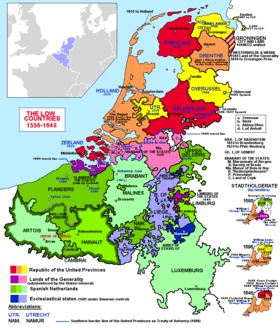
The governments of the remaining provinces, except for Friesland, tended to follow the pattern of Holland with some local variations.
Zeeland had almost the identical form of government as Holland had. It had 6 representative cities: Middelburg, Vlissingen, Ter Veere, Zierikzee, Goes and Tholen. William the Silent had bought the marquisate of Veere and Vlissingen in 1582 (see article on House of Orange-Nassau). This gave him the right to appoint the government (regents) in the first three cities, and made him First Noble (actually the only noble) in the province. He thus controlled 4 out of the 7 votes, and thus the province. William the Silent had been promised the countship of Holland and Zeeland before his death. This was not granted to his heirs. However, this was another version of it, writ small, and a thorn in the side of the regents of Holland from that day to the end of the Republic.[4][8]
Utrecht had a States consisting of Utrecht (the city), Amersfort, Montfoort, Rhenen, Wijk, and the Clergy (Utrecht had been governed by its bishop in the Middle Ages).
Gelderland's States were Arnhem, Den Bommel, Doesburg, Elburg, Groenlo, Hardewijk, Hattern, Lochem, Nijmegen, and the Nobility, which was very numerous there.
Groningen functioned as a city-state based on the city of Groningen. All representation flowed through there.
Overissel consisted of three representative towns: Deventer, Kampen, and Zwolle, as well as the Nobility.
Friesland, as said above, was different. It had its own language, Frisian, more akin to old English than Dutch. Its government was based on universal male suffrage and had a large dose of democracy surviving from the Dark Ages. It was organized into four quarters. The Ostergo, which had 11 local subdivisions called Baillages. A baillage was a certain number of villages governed by a Greetman. The Westergo, 9 baillages. The Serenwolden, 10 baillages. The last quarter were the towns of Friesland, of which Leeuwarden was the capital. Each baillage sent 2 representatives to the States, and each town sent 2 representatives. Unlike the rest of the Generality, these representatives did not need to recourse to those who elected them to make a decision on how to vote.[2]
Arms of Voting Provinces:
 Arms of the Province of Holland and West Friesland.
Arms of the Province of Holland and West Friesland. Arms of the Province of Zeeland.
Arms of the Province of Zeeland.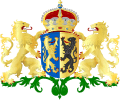 Arms of the Province of Gelderland.
Arms of the Province of Gelderland. Arms of the Province of Utrecht.
Arms of the Province of Utrecht. Arms of the Province of Friesland.
Arms of the Province of Friesland. Arms of the Province of Groningen.
Arms of the Province of Groningen. Arms of the Province of Overijssel.
Arms of the Province of Overijssel.
Arms of Non-Voting Provinces:
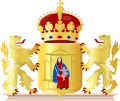 Arms of Drenthe (it was not a province and had no representation in the states General).
Arms of Drenthe (it was not a province and had no representation in the states General). Arms of North Brabant (the lands of the Generality). It was governed by the States General as conquered territory and had no representation in the States General.
Arms of North Brabant (the lands of the Generality). It was governed by the States General as conquered territory and had no representation in the States General. Arms of States Flanders: the part of the county of Flanders conquered by the armies of the Republic and administered as part of Zeeland.
Arms of States Flanders: the part of the county of Flanders conquered by the armies of the Republic and administered as part of Zeeland.
Government of the cities and towns
.svg.png)
Just as the State-General of the Generality could not make any decisions without consulting back with their principals at the States of the Provinces, the states of the provinces could not make major decisions without consulting back with their principals in the various cities and towns. As noted above, this lack of delegation of sovereignty led to a fair degree of inertia and would have been unworkable in a larger country less well connected with transport (albeit waterborne canals and shipping) links. It did, however, give the cities and towns a large amount of freedom. Also, the sovereignty of the provincial states was in practice dependent for its exercise on the magistrates of the cities.[1][2][5]
Each of the towns and cities in the seven provinces had its own differences and peculiarities. However, as a general rule, the government of the city of Amsterdam is fairly standard. Also, as noted above, in the 17th and 18th century, the wealth that Amsterdam made from commerce made it the most powerful city in the province of Holland, accounting for half of Holland's revenues and taxes and through that a full quarter of the Generality's. Because of this economic weight, it was the most influential voice in the councils of the province and the Generality.[5]

The government of the city was from a very early time in the hands of four Burgomasters (in Dutch "Burgemeester" but better translated to English as "mayors"), largely for the same reason that Rome had two consuls: deconcentration of power. Originally, the burgomasters were appointed by the lord or the province, the Count of Holland and their successors, the Duke of Burgundy. As the Burgundian Dukes tended to have national interests to occupy them, the appointments were often left to their stadholders. From the 15th century on, however, their election was by a complex system. An electoral college was formed yearly, made up of the outgoing burgomasters, the alderman (City Councilmen), and all those who in the past had held the post of burgomaster or alderman. The burgomasters are chosen by simple majority. In the second stage of the election, the three newly elected burogmasters "copted" (chose) one of the outgoing (4) to stay on for a second year. In this way, one of the burogmasters stayed in office two years to provide continuity.[1][2]
The three newly chosen were called "Reigning-Burgomasters" for that year. For the first three months after a new election, the Burgomaster of the year before presides. After that time, it was supposed the new ones had learned the "Forms and Duties of their Office", and acquainted with the state of the city's affairs, so the three new burgomasters had the privilege to preside by turns.[2]
The burgomasters functioned as the executive of the city government. They were in command of the civic guard (the famous militia companies of the Dutch paintings) and troops stationed in the city. They appointed the city functionaries such as the administrators in charge of the welfare of orphans and of vacant succession, charitable institutions, and the captains of the companies of the civic guard. issue out all Monies out of the common Stock or Treasure, judging alone what is necessary for the Safety, Convenience, or Dignity of the City. They also kept the Key of the Bank of Amsterdam, which in the day functioned as one of the central banks of the nations of Europe. The vaults were never opened without one of them present. They also were in charge of all the public works of the city, such as the ramparts, public buildings (for example the great Amsterdam City Hall, now a Royal Palace).

The salary of a Burgomaster of Amsterdam was 500 Gilders a year, though there are offices worth 10 times as much at their disposal. None of them was known to have taken bribes: a credit to the integrity of the system.[2]
Most cities, Amsterdam being no exception, employed a pensionary. He was the leading functionary and legal adviser of the principal town corporations in the Netherlands. They received a salary, or pension, hence the name. At first this official was known by the name of clerk or advocate. The office originated in Flanders. The earliest pensionaries in Holland were those of Dordrecht (1468) and of Haarlem (1478). The pensionary conducted the legal business of the town, and was the secretary of the city council. He was also one of the city's representatives and spokesman at the meetings of the Provincial States. The post of pensionary was permanent. As the official who kept a large part of the town's business in his hands, and had the most knowledge and experience, his influence was as great on the city level as the corresponding office, the Councilor Pensionary of Holland, was at the provincial and national level. Johan de Witt was originally pensionary of Dordrect before he was appointed Councilor Pensionary of Holland.
The official responsible for the administration of justice was the schout. In former times he was the representative of the count of Holland. During the 16th, 17th, and 18th centuries, he was appointed by the burgomasters. In other towns and cities in Holland, this appointment was the prerogative of the States of Holland. The schout was the chief of police and the public prosecutor ("district attorney" in the US, Crown Prosecutor in the UK). The schout, through the colony of New Netherland (the present New York and New Jersey), is the origin of the American institution of district attorney and attorney general.[9]
The schout also functioned as president of the Tribunal of Alderman, which sat as judges in the cases brought before it by the schout. They are the court of last appeal in criminal cases. They did not pass a death sentence without first advising the burgomasters of the possibility of that decision. Other than that, the burgomasters had no role in the process. In civil cases, after a certain value, there was a right of appeal to the Court of Justice of the Province in the Hague. The Tribunal consisted of (9) alderman. The aldermen were chosen annually by the stadholder from a list of 14 presented to it by the Vroedschap or City Senate. In the absence of a stadholder, as in 1650–72 and 1702–48, the aldermen were chosen by the burgomasters. Seven are chosen annually, two from the previous year continued in office. The list is compiled by the city council or Vroedschap.[2]
The Vroedschap or City Council was really a Senate in the ancient Roman Republican sense. As a fourth branch of the city government, it was a direct backup to the power of the burgomasters. It was a college of (36) members, "men both rich and wise" whose task was to "counsel" the burgomasters. Its members were called vroedman, literally a "wise man". An honorific title of the vroedschap was the vroede vaderen, or the "wise fathers", again, very much like the ancient Roman Senate, the modern word senate being derived from the Latin word senātus (senate), which comes from senex, "old man". Vacancies were filled by co-option, i.e. by vote of the members of the Vroedschap. Membership was for life. In the past, election to the Vroedschap had been by majority of citizens gathered in a large assembly, usually at a large church. This practice was discontinued in favor of the co-option system around the year 1500.[1][2]
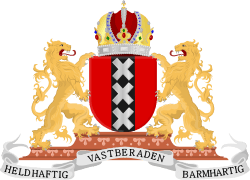
The influence of the Vroedschap on the city government had its precedence again in that of the Roman Senate. As the members of the city government who were burgomasters, aldermen, and other city officials were chosen for the Vroedschap, and the vroedmen tended to choose each other for these offices, there developed an oligarchy. The members of the four colleges above that constituted the city government belonged to relatively small group of rich merchant, financial or land-owning families, many closely interrelated. It was not impossible to gain access, by success in business and being co-opted into the Vroedschap and the other colleges. This was most likely to happen when the stadholder of the day appointed a new person into one of the colleges. The system was not immune to popular pressure, as events of the age showed, but it became tighter and more closed as time went on until the Republic fell. A son of family belonging to the regent class there opened up an equivalent of the Roman cursus honorum where he could show his talents and make the connections that would serve him and his city. As these same officials were appointed to provincial offices (e.g. delegate to the States of Holland, member of one of the admiralty boards) or offices under the Generality (ambassadors), the councils of local power perpetuated themselves into the regional and national levels.
First Stadtholderless period and the Great Assembly
The First Stadtholderless Period or Era (1650–72; Dutch: Eerste Stadhouderloze Tijdperk) is the period in the history of the Dutch Republic in which the office of a Stadtholder was absent in five of the seven Dutch provinces (the provinces of Friesland and Groningen, however, retained their customary stadtholder from the cadet branch of the House of Orange). It happened to coincide with the period when it reached the zenith of its economic, military and political Golden Age.

Politically, the Staatsgezinde (Republican) faction of the ruling Dutch Regents, led by such talented men as Johan de Witt, his brother Cornelis de Witt, Cornelis de Graeff, Andries de Graeff and Andries Bicker (the last three uncles of Johan de Witt's wife) dominated. It was fortunate for the Republic that capable leadership arose in the absence of a Prince of Orange. The faction even thought through an ideological justification of republicanism (the "True Freedom") that went against the contemporary European trend of monarchical absolutism, but previewed "modern" political ideas that eventually found their fullest expression in the American and French constitutions of the 18th century. There was a "monarchical" opposing undertow, however, from the adherents of the House of Orange that wanted to restore the young Prince of Orange to the position of Stadtholder that his father, grandfather, great-uncle, and great-grandfather had held. The republicans attempted to rule this out by constitutional prohibitions, like the Act of Seclusion, but were eventually unsuccessful in the crisis of the Rampjaar (Year of Disaster) of 1672, that brought about the fall of the De Witt-regime.[4][5][8]
The Gecommitteerde Raden (executive committee) of the States of Holland moved immediately to reassert their authority over the army and convened a plenary session of the States. Next Holland proposed in the States General that a so-called Great Assembly (a kind of constitutional convention) should be convened at short notice, to amend the Union of Utrecht.[10]>:702–703
The States of Holland did not await this Assembly, however, but for their own province immediately started to make constitutional alterations. On December 8, 1650, the States formally took over their Stadtholders' powers. The eighteen voting towns in the States were given the option to apply for a charter that enabled them to henceforth elect their own vroedschap members and magistrates, under ultimate supervision of the States, but otherwise without the usual drawing up of double lists, for outsiders to choose from. This did not apply to the non-voting towns, however, that still had to present double lists, but now to the States, instead of the Stadtholder. The States also assumed the power to appoint magistrates in the unincorporated countryside, like drosten and baljuws.[5][10] :703–704
This did imply a significant change in the power structure in the province. The position of the city regents was improved, while the ridderschap (the oligarchical representative body of the nobility in the States, that had one vote, equal to one city) lost influence, especially in the countryside. The change also diminished the power of the representative bodies of the guilds in the cities, that had often acted as a check on the power of the vroedschap with the help of the stadtholder. The change therefore did not go unopposed, and caused some rioting by the groups being disenfranchised.[5][10] :704
Political parties
There was a periodic power struggle between the Orangists, who supported the stadtholders/House of Orange-Nassau, and the Staatsgezinden (Republicans), who supported the States-General and hoped to replace the semi-hereditary nature of the stadtholdership with a true republican structure. It would be a mistake to think of those as modern political parties. They were really loosely aligned groupings of interests and families that sought power in the State. Many of the people and groupings that were part of one faction could as easily be found at later times in different factions as their interests and family alliances changed.[4][5][8]
As noted above, the Staatsgezinde developed out of the Loevestein Faction of Johan van Oldenbarnelt.[5] Behind the theological debate of the Remonstrant-CounterRemonstrant clash lay a political one between Prince Maurice, a strong military leader, and his former mentor Johan van Oldenbarnevelt, Land's Advocate of Holland and personification of civil power. Maurice desired war with Holland's enemy, Roman Catholic Spain. War would preserve his power and influence in the State. There was also no small part of revenge against Spain for assassinating his father. As Maurice is purported to have said, "I know not whether predestination is black or white, but I will make it orange."[7] Oldenbarnevelt, along with Arminius and his followers, desired peace. They saw no great benefit to the continuation of war and real danger to Holland's developing trade. They also saw the sovereignty of the States of Holland as paramount. In their eyes, this meant state supremacy over the church.[5][6][7][10][11] Personally, many of the regents were Counter-Remonstrant minded, but the coalition suited their political interests at the time.[12]
Because of this, an influential part of the regents had never been reconciled to Maurice of Orange's treatment of their colleagues, in part because they were related to them. When William II died in 1650 with only a posthumous son (William III), the regents of Holland and the Statengezinde stepped into the vacuum. The Staatsgezinde at the height of the Republic in the First Stadholderless Period were led by such talented men as Johan de Witt, his brother Cornelis de Witt, Cornelis de Graeff, Andries de Graeff and Andries Bicker. During the Second Statholderless period, the Statengezinde were again led by the Raadpensionaris of the time. As also noted above, the faction even thought through, at least during De Witt's time, an ideological justification of republicanism Ware Vrijheid (the "True Freedom") that went against the contemporary European trend of monarchical absolutism. De Witt and his allies primarily defended Oldenbarnevelt's and Grotius' claim to supremacy of (Holland's) provincial sovereignty over the sovereignty of the Generality. But the doctrine went further. "True Freedom" implied the rejection of an "eminent head", not only of the federal state (where it would have conflicted with provincial sovereignty), but also of the provincial political system. De Witt considered Princes and Potentates as such, as detrimental to the public good, because of their inherent tendency to waste tax payer's money on military adventures in search of glory and useless territorial aggrandizement. As the province of Holland only abutted friendly territory and its interests were centered on commercial activities at sea, the Holland regents had no territorial designs themselves, and they looked askance at such designs by the other provinces, because they knew they were likely to have to foot the bill.[5][8]
This doctrine was formalized in works by De Witt himself on economics as well as his cousin's (also John de Wit) work on the "Public Gebedt" (Public Debt). By far the most complete reasoning behind the Republican regime came from Peter de la Court. The most famous of these, "The Interest van Holland" was published in 1662 and immediately became a bestseller in Holland and later also elsewhere. The book contained an analysis of the miraculous economic success of Holland, the leading province of the Dutch Republic, and then set out to establish the economic and political principles on which that success was based. De la Court identified free competition and the republican form of government as the leading factors contributing to the wealth and power of his home country. The book was written in an outspoken and polemic style and went through eight editions in 1662. A revised luxury edition appeared in 1669. It was translated into German in 1665, English in 1702 and French in 1709. A new English translation appeared as late as 1746. The text of the last English edition of the Interest can be downloaded from the website of the Liberty Fund: Pieter de la Court, The True Interest and Political Maxims, of the Republic of Holland (1662).
There was a "monarchical" opposing movement, however, came from the adherents of the House of Orange, loosely grouped into the "Orangist" faction, that wanted to restore the young Prince of Orange to the position of Stadtholder that his father, grandfather, great-uncle, and great-grandfather had held. Their adherence to the Prince of Orange's dynastic interest was partly a matter of personal advancement, as many Orangist regents resented being ousted from the offices they had monopolized under the Stadtholderate. Many adherents were also relatives of the House of Orange (i.e. the House of Nassau) and minor nobles whose influence would be greater under an "eminent" head such as a Prince of Orange, who could be a prime mover in the State and the Army and thus a dispenser of patronage. It was also, for members of the lower nobility, perfectly reasonable that they should be led by the fairly royal Prince of Orange in an age when all other nations were led by Kings and Emperors.[5][8]
Many people also had a genuine ideological attachment to the "monarchical" principle. As the analogy of the Dutch Republic with the biblical People of Israel was never far from people's minds, this helped to give an important underpinning for the Orangist claims in the mind of the common people, who were greatly influenced from the pulpit. The Prince of Orange was seen in his traditional role as the leader of the nation in its independence movement, and its protector from foreign threats.[8] References to biblical kings were never far from most of the Calvinist preacher's sermons. Other favorite metaphors were the likening of the Princes of Orange to Moses leading the people of the Netherlands out of the Spanish "house of bondage". Given the prevalence of dangers from floods, the Lord was seen as having placed the protection of the Dutch people from inundation, both physical and metaphysical religious terms in the hands of the Princes of Orange.[11] Of course, the conservative Calvinist Reformed Church thought its interests best served by the Stadtholder from the House of Orange who had served them in the Remonstrant-CounterRemonstrant controversy in 1619 under Maurice of Orange that culminated in the Synod of Dort. The Erastianism of the Holland regents was seen as a constant threat to its independence and orthodoxy.[5]
The Republicans attempted to rule out the return of the House of Orange and cement their rule by constitutional prohibitions, like the Act of Seclusion (demanded by Cromwell, but not resisted by the Republicans). They were eventually unsuccessful in the crisis of the Rampjaar (Year of Disaster) of 1672, as the majority of the people turned to the Prince of Orange (William III in the crisis. That brought about the fall of the De Witt-regime. Similarly, in the crisis of the French invasion of 1747, the Republican regime collapsed and brought about the installation of William IV as Stadholder. During the Anglo-French war (1778), the internal territory was divided into groups: the Patriots, who were pro-French and pro-American and the Orangists, who were pro-British.[13]
Influence
The framers of the U.S. Constitution were influenced by the Constitution of the Republic of the United Provinces. They took from the Dutch Republic the idea of a "sovereign union of sovereign states". They also took from the Dutch example the need for political and administrative power to be exercised and interlocked at different levels: local, regional and national. The other great example taken from the Dutch was the ability to compromise in order to achieve a goal for the common good. However, the Dutch Republic, as cited in the Federalist papers by Hamilton, provided an example to be avoided of not allowing the (Con)Federal national government sufficient power to carry out its duties, collect its revenue, and come to decisions in a timely manner as set down in law.[14]
In addition, the Act of Abjuration, essentially the declaration of independence of the United Provinces, is strikingly similar to the later American Declaration of Independence,[15] though concrete evidence that the former directly influenced the latter is absent.
List of office holders
The lists of Stadtholders can be found here and here.
| Name |
Lifespan |
Reign start |
Reign end |
Notes |
Family |
Image |
|---|---|---|---|---|---|---|
William I
|
24 April 1533 – 10 July 1584 (aged 51) | 1559 | 1584 | Stadtholder[16] | Orange-Nassau |  |
Maurice
|
14 November 1567 – 23 April 1625 (aged 57) | 1585 | 1625 | Stadtholder,[17] son of William I | Orange-Nassau |  |
Frederick Henry
|
29 January 1584 – 14 March 1647 (aged 63) | 1625 | 1647 | Stadtholder,[18] son of William I | Orange-Nassau | 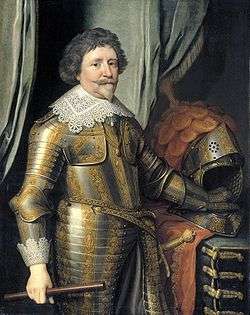 |
William II
|
27 May 1626 – 6 November 1650 (aged 24) | 14 March 1647 | 6 November 1650 | Stadtholder,[19] son of Frederick Henry | Orange-Nassau | 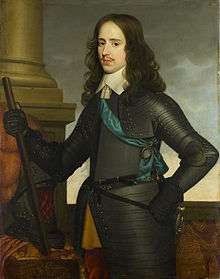 |
William III
|
4 November 1650 – 8 March 1702 (aged 51) | 4 July 1672 | 8 March 1702 | Stadtholder,[20] son of William II[21] | Orange-Nassau | _(lighter).jpg) |
William IV
|
1 September 1711 – 22 October 1751 (aged 40) | 1 September 1711 (under the regency of Marie Louise until 1731) | 22 October 1751 | Hereditary Stadtholder of the United Netherlands,[22] son of John William Friso | Orange-Nassau |  |
William V
|
8 March 1748 – 9 April 1806 (aged 58) | 22 October 1751 | 9 April 1806 | Hereditary Stadtholder of the United Netherlands, son of William IV, succeeded by his son King William I (-> Principality of the Netherlands (1813 - 1815) | Orange-Nassau | 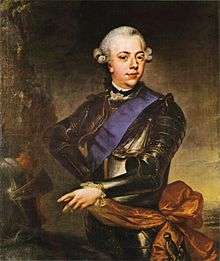 |
| Name |
Lifespan |
Reign start |
Reign end |
Notes |
Family |
Image |
|---|---|---|---|---|---|---|
John VI
|
22 November 1536 – 8 October 1606 (aged 69) | 1578 | 1581 | Stadtholder,[23] brother of William I | Nassau |  |
William Louis
|
13 March 1560 – 31 May 1620 (aged 60) | 1584 | 1620 | Stadtholder,[24] son of John VI | Nassau |  |
| Ernest Casimir I
|
22 December 1573 – 2 June 1632 (aged 58) | 1620 | 1632 | Stadtholder,[25] son of John VI | Nassau | .jpg) |
| Henry Casimir I
|
21 January 1612 – 13 July 1640 (aged 28) | 1632 | 1640 | Stadtholder,[26] son of Ernest Casimir I | Nassau |  |
| William Frederick
|
7 August 1613 – 31 October 1664 (aged 51) | 1640 | 1664 | Stadtholder,[27] son of Ernest Casimir I | Nassau | _Governor_of_Frisia_1664.jpg) |
| Henry Casimir II
|
18 January 1657 – 25 March 1696 (aged 39) | 18 January 1664 | 25 March 1696 | Hereditary Stadtholder,[28] son of William Frederick | Nassau |  |
| John William Friso
|
4 August 1687 – 14 July 1711 (aged 23) | 25 March 1696 | 14 July 1711 | Hereditary Stadtholder,[29] son of Henry Casimir II, succeeded by his son William IV of Orange-Nassau, Hereditary Stadtholder of the United Netherlands (-> Stadtholderate under the House of Orange-Nassau | Nassau, Orange-Nassau |  |
The lists of The full list of pensionaries can be found here. During the Republic, the Councilor Pensionaries of Holland ("Grand Pensionaries") were:
| Portrait | Name (Birth–Death) |
Term of office | ||
|---|---|---|---|---|
 |
Paulus Buys (1531–1594) |
1572 | 16 March 1584 | |
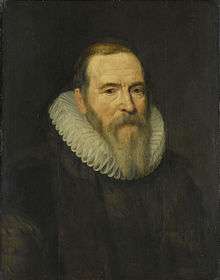 |
Johan van Oldenbarnevelt (1547–1619) |
16 March 1586 |
12 May 1619 | |
| Andries de Witt (1573–1637) |
12 May 1619 |
1621 | ||
| Anthonie Duyck (1560–1629) |
1621 | 1629 | ||
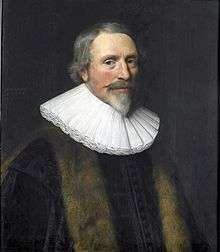 |
Jacob Cats (1577–1660) |
1629 | 1631 | |
.jpg) |
Adriaan Pauw (1585–1653) |
1631 | 1636 | |
 |
Jacob Cats (1577–1660) |
1636 | 1651 | |
.jpg) |
Adriaan Pauw (1585–1653) |
1651 | 30 July 1653 | |
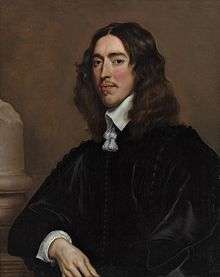 |
Johan de Witt (1625–1672) |
30 July 1653 |
4 August 1672 | |
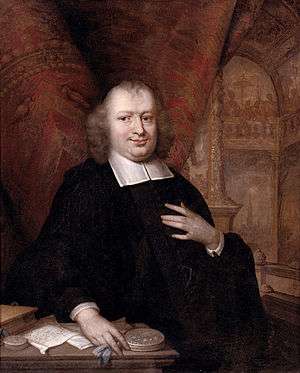 |
Gaspar Fagel (1634–1688) |
20 August 1672 |
5 December 1688 | |
 |
Michiel ten Hove (1640–1689) |
5 December 1688 |
24 March 1689 | |
| Anthonie Heinsius (1641–1720) |
27 May 1689 |
3 August 1720 | ||
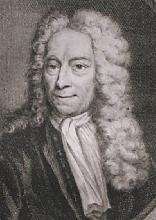 |
Isaac van Hoornbeek (1655–1727) |
12 September 1720 |
17 June 1727 | |
.jpg) |
Simon van Slingelandt (1664–1736) |
17 July 1727 |
1 December 1736 | |
 |
Anthonie van der Heim (1693–1746) |
4 April 1737 |
7 July 1746 | |
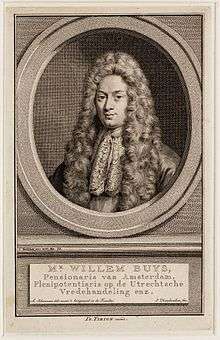 |
Willem Buys (1661–1749) |
7 July 1746 |
23 September 1746 | |
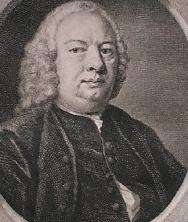 |
Jacob Gilles (1691–1765) |
23 September 1747 |
18 June 1749 | |
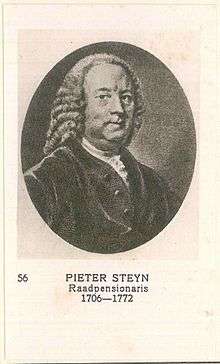 |
Pieter Steyn (1706–1772) |
18 June 1749 |
5 November 1772 | |
%2C_raadpensionaris_van_Holland_Rijksmuseum_SK-A-4336.jpeg) |
Pieter van Bleiswijk (1724–1790) |
18 June 1772 |
5 November 1787 | |
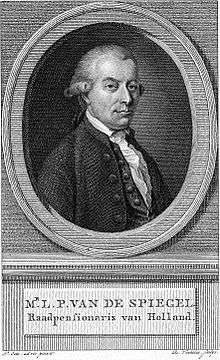 |
Laurens Pieter van de Spiegel (1736–1800) |
9 November 1787 |
9 February 1795 | |
and in Zeeland:
| Portrait | Name (Birth–Death) |
Term of office | ||
|---|---|---|---|---|
| Christoffel Roels (1540–1597) |
3 July 1578 |
18 May 1597 | ||
| Johan van de Warck (died 1615) |
25 March 1599 |
24 November 1614 | ||
| Bonifacius de Jonge (1567–1625) |
18 February 1615 |
June 1625 | ||
| Johan Boreel (1577–1629) |
28 October 1625 |
1 November 1629 | ||
| Boudewijn de Witte | 19 February 1630 |
23 March 1641 | ||
| Cornelis Adriaansz. Stavenisse (1595–1649) |
19 April 1641 |
28 May 1649 | ||
 |
Johan de Brune (1589–1658) |
16 August 1649 |
7 November 1658 | |
| Adriaan Veth (1608–1663) |
29 November 1658 |
25 November 1663 | ||
 |
Pieter de Huybert (1622–1697) |
19 March 1664 |
9 October 1687 | |
| Jacob Verheije (1640–1718) |
10 October 1687 |
16 August 1718 | ||
 |
Caspar van Citters (1674–1734) |
28 November 1718 |
28 September 1734 | |
| Dignus Francois Keetlaer (1674–1750) |
2 November 1734 |
23 March 1750 | ||
| Johan Pieter Recxstoot (1701–1756) |
31 May 1751 |
31 January 1756 | ||
| Jacob du Bon (c. 1695–1760) |
3 January 1757 |
1 June 1760 | ||
.jpg) |
Wilhem van Citters (1723–1802) |
15 December 1760 |
25 May 1766 | |
| Adriaan Steengracht (1731–1770) |
26 May 1766 |
6 May 1770 | ||
| Johan Marinus Chalmers (1720–1796) |
13 August 1770 |
12 May 1785 | ||
 |
Laurens Pieter van de Spiegel (1737–1800) |
22 September 1785 |
24 April 1788 | |
.jpg) |
Willem Aarnoud van Citters (1741–1811) |
25 April 1788 |
1795 | |
Batavian Republic
Grand Pensionaries of the Batavian Republic:
| Portrait | Name (Birth–Death) |
Term of office | Faction | |
|---|---|---|---|---|
 |
Rutger Jan Schimmelpenninck (1761–1825) |
15 May 1805 |
4 June 1806 |
Moderate |
_2.jpg) |
Carel de Vos van Steenwijk (1759–1830) |
4 June 1806 |
18 June 1806 |
Federalist |
See also
See also
- History of the Netherlands
- Union of Utrecht
- Eighty Years' War
- Dutch Golden Age
- List of Grand Pensionaries
- Land's Advocate of Holland
- Stadholder
- List of stadtholders for the Low Countries provinces
References
- 1 2 3 4 5 6 7 Haley, K(enneth) H(arold) D(obson) (1972). The Dutch in the Seventeenth Century. Thames and Hudson. p. 78. ISBN 0-15-518473-3.
- 1 2 3 4 5 6 7 8 9 Temple, Sir William (October 18, 2011) [1668], Observations upon the United Provinces of the Netherlands (7th ed.), London: Jacob Tonfon within Grays-Inn Gate next Grays-Inn Lane, and Awnfoam and John Churchill at the Black Swan in Tater-No/ler-Row* Check date values in:
|year= / |date= mismatch(help) - 1 2 Motley, John Lothrop (1855). The Rise of the Dutch Republic. Harper & Brothers.
- 1 2 3 4 5 Rowen, Herbert H. (1988). The princes of Orange: the stadholders in the Dutch Republic. Cambridge University Press. p. 29. ISBN 0-8063-4811-9.
- 1 2 3 4 5 6 7 8 9 10 11 12 13 14 15 16 17 18 19 Rowen, Herbert H. (1978). John de Witt, grand pensionary of Holland, 1625-1672. Princeton University Press.
- 1 2 Blok, Petrus Johannes (1898). History of the people of the Netherlands. New York: G. P. Putnam's sons.
- 1 2 3 Motley, John Lothrop (1860). History of the United Netherlands from the Death of William the Silent to the Synod of Dort. London: John Murray.
- 1 2 3 4 5 6 Geyl, Pieter (2002). Orange and Stuart 1641-1672. Arnold Pomerans (trans.) (reprint ed.). Phoenix.
- ↑ Joan E. Jacoby (May–June 1997). "The American Prosecutor in Historical Context" (PDF). The Prosecutor. Retrieved 2008-02-25.
- 1 2 3 4 Israel, Jonathan I. (1995). The Dutch Republic: Its Rise, Greatness and Fall, 1477-1806. Oxford University Press. ISBN 0-19-873072-1.
- 1 2 Schama, Simon (1987). The Embarrassment of Riches: An Interpretation of Dutch Culture in the Golden Age. Alfred A. Knopf. ISBN 0-394-51075-5.
- ↑ Edwin Rabbie (1995). Hugo Grotius: Ordinum Hollandiae ac Westfrisiae Pietas, 1613. Brill.
- ↑ Ertl 2008, p. 217.
- ↑ Alexander Hamilton, James Madison (1787-12-11). Federalist Papers no. 20. Retrieved 2011-07-08.
- ↑ Barbara Wolff (1998-06-29). "Was Declaration of Independence inspired by Dutch?". University of Wisconsin–Madison. Retrieved 2007-12-14.
- ↑ Stadtholder of Holland, Zeeland and Utrecht (employed by Philip II: 1559 – 1567, employed by the States General: 1572 – 1584), Stadtholder of Friesland and Overijssel (1580 – 1584)
- ↑ Stadtholder of Holland and Zeeland (1585 – 1625), Utrecht, Guelders and Overijssel (1590 – 1625), Groningen (1620 – 1625)
- ↑ Stadtholder of Holland, Zeeland, Utrecht, Guelders, and Overijssel (1620 – 1625), Groningen and Drenthe (1640 - 1647)
- ↑ Stadtholder of Holland, Zeeland, Utrecht, Guelders, Groningen, Drenthe and Overijssel
- ↑ Stadtholder of Holland, Zeeland, Utrecht and Overijssel (1672 - 1702), Guelders (1675 - 1702), Drenthe (1696 - 1702)
- ↑ William III invaded - on invitation - England and became king of England, Scotland and Ireland
- ↑ Hereditary Stadtholder of Friesland (1711 – 1747), Holland, Zeeland, Utrecht and Overijssel (April/May 1747 – November 1747), Stadtholder of Groningen (1718 – 1747), Guelders and Drenthe (1722 – 1747), was formally voted the first Hereditary Stadtholder of the United Provinces (1747 - 1751)
- ↑ Stadtholder of Guelders (under Philip II), architect of the Union of Utrecht
- ↑ Stadtholder of Friesland (1584 – 1620), Groningen (1594 – 1620) and Drenthe (1596 – 1620)
- ↑ Stadtholder of Friesland (1620 - 1632), Groningen and Drenthe (1625 - 1632)
- ↑ Stadtholder of Friesland (1632 - 1640), Groningen and Drenthe (1632 - 1640)
- ↑ Stadtholder of Friesland (1640 - 1664), Groningen and Drenthe (1650 - 1664)
- ↑ In 1675 the State of Friesland voted to make the Stadtholdership hereditary in the house of Nassau-Dietz
- ↑ Hereditary Stadtholder of Friesland (1707 - 1711) and Griningen (1708 - 1711)
Further reading/Bibliography
- Ertl, Alan W. (2008). Toward an Understanding of Europe: A Political Economic Précis of Continental Integration. Universal-Publishers. ISBN 978-1-59942-983-0.
- John Lothrop Motley, "The Rise of the Dutch Republic". New York: Harper & Brothers, 1855.
- John Lothrop Motley, "History of the United Netherlands from the Death of William the Silent to the Synod of Dort". London: John Murray, 1860.
- Herbert H. Rowen, John de Witt, grand pensionary of Holland, 1625-1672. Princeton, N.J.: Princeton University Press, 1978, which is summarized in
- Herbert H. Rowen, "John de Witt: Statesman of the "True Freedom"". Cambridge University Press, 2003.
- Herbert H. Rowen, The princes of Orange: the stadholders in the Dutch Republic. Cambridge and New York: Cambridge University Press, 1988.
- Herbert H. Rowen, The princes of Orange: the stadholders in the Dutch Republic. Cambridge and New York: Cambridge University Press, 2003.
- Petrus Johannes Blok, "History of the people of the Netherlands". New York: G. P. Putnam's sons, 1898.
- Pieter Geyl, "Orange and Stuart, 1641-1672". Scribner, 1970.
- Jonathan I. Israel, "The Dutch Republic: Its Rise, Greatness, and Fall, 1477–1806" Oxford University Press, 1995. ISBN 0-19-820734-4
- Reynolds, Clark G. Navies in History. Annapolis: Naval Institute Press, 1998
- Schama, Simon The Embarrassment of Riches: An Interpretation of Dutch Culture in the Golden Age. New York: Random House USA, 1988
- Sir William Temple: Temple, Sir William (October 18, 2011) [1668]. Observations upon the United Provinces of the Netherlands (7th ed.). London: Jacob Tonfon within Grays-Inn Gate next Grays-Inn Lane, and Awnfoam and John Churchill at the Black Swan in Tater-No/ler-Row*. Check date values in:
|year= / |date= mismatch(help)
Coordinates: 52°04′48″N 4°18′00″E / 52.08000°N 4.30000°E